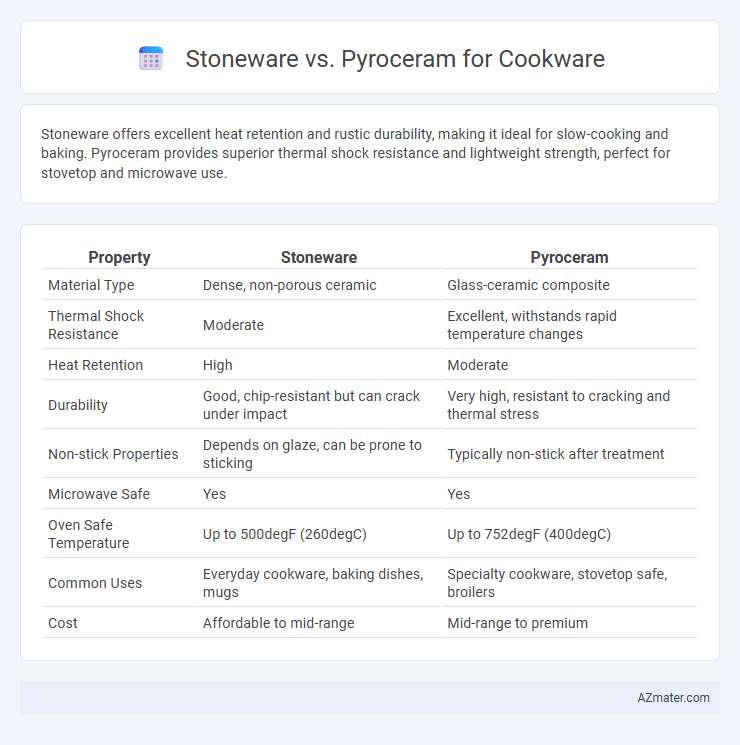Stoneware offers excellent heat retention and rustic durability, making it ideal for slow-cooking and baking. Pyroceram provides superior thermal shock resistance and lightweight strength, perfect for stovetop and microwave use.
Table of Comparison
| Property | Stoneware | Pyroceram |
|---|---|---|
| Material Type | Dense, non-porous ceramic | Glass-ceramic composite |
| Thermal Shock Resistance | Moderate | Excellent, withstands rapid temperature changes |
| Heat Retention | High | Moderate |
| Durability | Good, chip-resistant but can crack under impact | Very high, resistant to cracking and thermal stress |
| Non-stick Properties | Depends on glaze, can be prone to sticking | Typically non-stick after treatment |
| Microwave Safe | Yes | Yes |
| Oven Safe Temperature | Up to 500degF (260degC) | Up to 752degF (400degC) |
| Common Uses | Everyday cookware, baking dishes, mugs | Specialty cookware, stovetop safe, broilers |
| Cost | Affordable to mid-range | Mid-range to premium |
Introduction to Stoneware and Pyroceram Cookware
Stoneware cookware is crafted from dense, non-porous clay fired at high temperatures, offering excellent heat retention and even cooking, making it ideal for baking and slow-cooking applications. Pyroceram cookware, composed of glass-ceramic material, provides superior thermal shock resistance, allowing it to withstand rapid temperature changes without cracking, perfect for stovetop-to-oven versatility. Both materials deliver durable, non-reactive cooking surfaces, but Pyroceram's advanced technology ensures enhanced durability and performance in diverse cooking environments.
Material Composition and Manufacturing Process
Stoneware cookware is made from dense, non-porous clay that is fired at high temperatures, resulting in a durable, heat-retentive surface ideal for slow cooking and baking. Pyroceram is a glass-ceramic material composed of crystalline and glass phases, manufactured through controlled nucleation and crystallization, offering exceptional thermal shock resistance and rapid heat conduction. The dense molecular structure of stoneware enhances moisture retention, while pyroceram's unique crystalline matrix ensures durability under rapid temperature changes without cracking.
Heat Resistance and Thermal Shock Strength
Stoneware offers moderate heat resistance and can withstand gradual temperature changes but is prone to cracking under sudden thermal shock. Pyroceram, a glass-ceramic material, exhibits exceptional heat resistance up to 1000degF (538degC) and superior thermal shock strength, allowing rapid temperature changes without damage. This makes Pyroceram ideal for cookware that transitions from stovetop to oven, whereas stoneware requires more cautious temperature handling to prevent breakage.
Cooking Performance and Heat Distribution
Stoneware offers excellent heat retention, distributing heat evenly for slow, consistent cooking ideal for baking and roasting. Pyroceram, a glass-ceramic material, provides superior thermal shock resistance and rapid, uniform heat transfer, making it suitable for stovetop use and quick temperature changes. While stoneware excels in maintaining steady heat for long durations, Pyroceram ensures precise temperature control and durability under intense heat variations.
Durability and Longevity Comparison
Stoneware cookware offers excellent thermal shock resistance but may be prone to chipping over extended use, affecting its longevity. Pyroceram, a glass-ceramic material, demonstrates superior durability with high resistance to thermal stress, scratches, and cracking, resulting in longer-lasting performance. The inherent toughness and non-porous nature of Pyroceram make it ideal for heavy-duty cooking tasks, outperforming traditional stoneware in durability and lifespan.
Versatility: Oven, Stovetop, and Microwave Use
Stoneware offers excellent oven and microwave safety but typically cannot withstand direct stovetop heat, limiting its versatility for certain cooking methods. Pyroceram excels in versatility, as it can safely transition from stovetop to oven and microwave without thermal shock or damage, making it ideal for a wide range of cooking techniques. Cookware made from Pyroceram provides enhanced flexibility for recipes requiring rapid temperature changes or multi-method preparation.
Maintenance and Cleaning Requirements
Stoneware cookware requires gentle cleaning using mild detergents and soft sponges to prevent surface damage and maintain its natural non-stick properties. Pyroceram cookware is highly durable, resistant to thermal shock, and can be cleaned with abrasive pads or in dishwashers without risking cracks or surface degradation. Regular maintenance of stoneware includes avoiding sudden temperature changes, while Pyroceram offers low-maintenance use with superior resistance to stains and scratches.
Aesthetic Options and Design Choices
Stoneware cookware offers a wide range of vibrant colors and handcrafted glazing techniques that create unique, rustic aesthetics, making each piece a decorative kitchen addition. Pyroceram cookware features a sleek, modern design with smooth, non-porous surfaces often in neutral tones, emphasizing durability and minimalist style. While stoneware emphasizes artisanal appeal and variety, Pyroceram prioritizes clean lines and functional aesthetics suited for contemporary kitchens.
Safety and Health Considerations
Stoneware cookware is generally non-toxic and free from harmful chemicals like lead and cadmium, making it a safe option for food preparation. Pyroceram, a type of glass-ceramic, is highly resistant to thermal shock and does not leach chemicals into food, enhancing its safety for cooking. Both materials offer inert surfaces that minimize the risk of contamination, but Pyroceram's superior heat resistance reduces the risk of cracking and potential exposure to contaminants from damaged cookware.
Cost and Value for Money
Stoneware cookware generally offers a lower upfront cost compared to Pyroceram, making it an attractive option for budget-conscious buyers. Pyroceram's higher price reflects its superior durability, thermal shock resistance, and versatility, providing greater long-term value and reduced replacement frequency. When evaluating cost versus value for money, Pyroceram often delivers enhanced performance and longevity that justify its premium price over stoneware alternatives.

Infographic: Stoneware vs Pyroceram for Cookware
 azmater.com
azmater.com